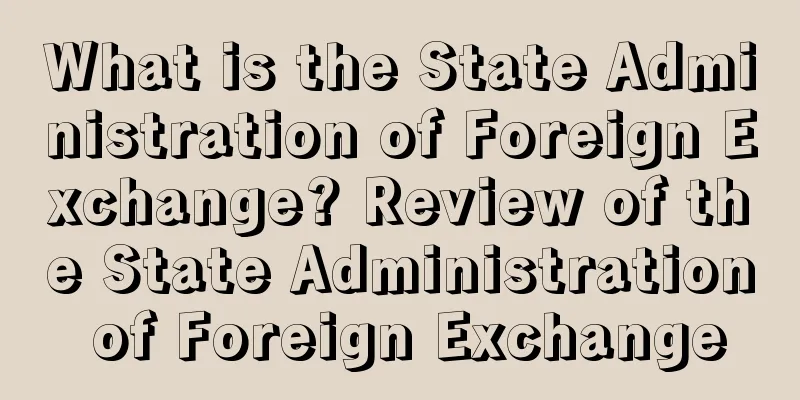What is the State Administration of Foreign Exchange? Review of the State Administration of Foreign Exchange

|
The State Administration of Foreign Exchange (SAFE) of the People's Republic of China is a national bureau managed by the People's Bank of China. It was established in March 1979 and its headquarters is located in Beijing. Established in March 1979 Website: https://www.safe.gov.cn/ The State Administration of Foreign Exchange is a vice-ministerial national bureau, which consists of seven functional departments, namely, General Affairs Department, Balance of Payments Department, Current Account Management Department, Capital Account Management Department, Management and Inspection Department, Reserve Management Department, and Personnel Department (Internal Audit Department), and the Party Committee of the Bureau. It also has four public institutions, namely, the Central Foreign Exchange Business Center, Information Center, Bureau Service Center, and China Foreign Exchange Magazine. History In 1978, the reform and opening up kicked off the reform of the foreign exchange management system. The reform of the foreign exchange management system has always been centered on the strategic deployment of the Party Central Committee and the State Council, and has been continuously promoted in the direction of the socialist market economy system. In accordance with the requirements of making the market play a decisive role in resource allocation and better play the role of the government, a foreign exchange management system that adapts to the requirements of the socialist market economy with Chinese characteristics has been gradually established. Since 1978, the reform of the foreign exchange management system has roughly gone through four stages of development. In the first stage (1978-1993), the reform of the foreign exchange management system started. This stage was characterized by strengthening the foreign exchange autonomy of enterprises and implementing a dual-track exchange rate system. In 1978, the Third Plenary Session of the 11th CPC Central Committee officially announced the start of my country's reform and opening up. In 1979, in order to cooperate with the reform of the foreign trade system and encourage enterprises to export and earn foreign exchange, my country began to implement the foreign exchange retention system. On the basis of centralized management and unified balance of foreign exchange by the state, export enterprises were given a certain proportion of foreign exchange purchase quotas, and enterprises were allowed to transfer excess foreign exchange through the foreign exchange swap market. Thus, a dual exchange rate system with the coexistence of official exchange rates and foreign exchange swap market exchange rates was gradually formed. During this stage, the foreign exchange management system was in the process of transition from a planned system to market regulation. Planned allocation of foreign exchange resources still occupied a dominant position, but the market mechanism emerged and continued to develop, playing a positive role in promoting the attraction of foreign investment, encouraging export and earning foreign exchange, and supporting domestic economic construction. In the second stage (1994-2000), the framework of the foreign exchange management system under the socialist market economy was initially determined. In early 1994, the state carried out major reforms to the foreign exchange management system, abolished the foreign exchange retention system, implemented the bank foreign exchange settlement and sales system, implemented a single, managed floating exchange rate system based on market supply and demand, and established a unified and standardized foreign exchange market. After that, the foreign exchange management system was further improved. In 1996, all restrictions on current international payments and transfers were abolished, and the RMB current account convertibility was realized. In 1997, the Asian financial crisis broke out, causing a serious impact on China's economic development and financial stability. In order to prevent the crisis from spreading further, my country made a commitment that the RMB would not depreciate, and focused on strengthening the management and crackdown on illegal and irregular capital flows such as evasion and fraud, successfully resisting the impact of the Asian financial crisis. Overall, during this stage, my country initially established a foreign exchange management system framework that was suitable for national conditions and adapted to the socialist market economy system, and the decisive position of the market in allocating foreign exchange resources was initially established. In the third stage (2001-2012), the foreign exchange management system, which is mainly based on market regulation, was further improved. Since joining the World Trade Organization at the end of 2001, my country has accelerated its integration into the global economy. The balance of payments has shown a continuous large surplus for a long period of time. Foreign exchange management has put forward the management goal of balancing the balance of payments and the regulatory concept of "balanced management". Major reform explorations, including the convertibility of RMB capital items, have been carried out in an orderly manner. In 2002, the Qualified Foreign Institutional Investor (QFII) system was established, and cross-border securities investment opening-up made significant progress. In 2003, Central Huijin Investment Co., Ltd. was established to inject capital into state-owned commercial banks, and foreign exchange reserves were explored for diversified use. Starting from the reform of the RMB exchange rate formation mechanism in July 2005, the supply and demand relationship in the foreign exchange market has been continuously straightened out. A series of reform measures have been implemented, including the abolition of the limit management of current account foreign exchange accounts, the implementation of a convenient foreign exchange settlement and sales quota management of US$50,000 for individuals, the launch of the Qualified Domestic Institutional Investor (QDII) system and the RMB Qualified Foreign Institutional Investor (RQFII) system. In 2008, in light of the fruitful results of the previous foreign exchange management system reform, the "Regulations of the People's Republic of China on Foreign Exchange Administration" was revised, and the legalization of foreign exchange administration entered a new stage. In 2009, the "five changes" in the concept and method of foreign exchange administration were proposed, and the simplification of administration and decentralization of power were promoted in an all-round way. In 2012, the reform of the foreign exchange administration system for trade in goods was implemented, and the system of verification and cancellation of foreign exchange receipts and payments for trade in goods was abolished, which greatly improved the degree of trade facilitation. In the fourth stage (2013 to date), the liberalization and facilitation of trade and investment and the prevention of cross-border capital flow risks were balanced. While maintaining the stability of the foreign exchange market, especially successfully coping with the high-intensity shocks in the foreign exchange market from the end of 2015 to the beginning of 2017, the reform and opening up of the foreign exchange field achieved historic achievements. In 2013, the foreign exchange management system for trade in services was reformed, and the prior approval of trade in services was completely abolished. All businesses were directly handled at banks. The two-way opening of the financial market was expanded, and new cross-border securities investment mechanisms such as the "Shanghai-Hong Kong Stock Connect" (2014), the mutual recognition of funds between the mainland and Hong Kong (2015), the "Shenzhen-Hong Kong Stock Connect" (2016), and the "Bond Connect" (2017) were successively launched. The Silk Road Fund, the China-Latin America Capacity Cooperation Fund, and the China-Africa Capacity Cooperation Fund were successively established to actively build a funding platform for the "Belt and Road". In 2015, the policy of willing settlement of capital was promoted nationwide, and the foreign exchange management of foreign direct investment was greatly simplified, making foreign direct investment basically convertible. From 2016 to 2017, we improved the macro-prudential management of cross-border financing of all calibers, promoted the two-way opening of the inter-bank bond market, and established and improved an open and competitive domestic foreign exchange market. In 2018, we further increased the QDII quota, cancelled the restrictions on the proportion of QFII funds remitted and the lock-up period requirements for QFII and RQFII, and expanded the pilot programs of qualified domestic limited partners (QDLP) and qualified domestic investment enterprises (QDIE). From the end of 2015 to the beginning of 2017, my country's foreign exchange market experienced two high-intensity shocks. Under the strong leadership of the CPC Central Committee and the State Council, the foreign exchange management department adopted comprehensive measures and addressed both the symptoms and root causes, established and improved the macro-prudential management of cross-border capital flows, and continuously improved the micro-regulation of the foreign exchange market. my country's increasingly open foreign exchange management system has withstood the test of the impact of cross-border capital outflows and effectively safeguarded the country's economic and financial security. The 19th CPC National Congress called for the promotion of a new pattern of comprehensive opening up, and listed the prevention and resolution of major risks as the first of the three major battles in the decisive period of building a moderately prosperous society in all respects. Faced with the two-way fluctuations in cross-border capital flows and the new normal of foreign exchange management under the new pattern of comprehensive opening up, the foreign exchange management department accelerated the construction of a two-in-one management framework of "macro-prudential + micro-regulation" for cross-border capital flows based on the experience of coping with high-intensity shocks in the foreign exchange market. Macro-prudential regulation uses market-based methods to counter-cyclically adjust the pro-cyclical fluctuations in the foreign exchange market, prevent the spread of international economic and financial risks across markets, institutions, currencies and borders, and maintain the basic stability of the foreign exchange market. Micro-regulation maintains the order of the foreign exchange market in accordance with laws and regulations, emphasizes anti-money laundering, anti-terrorist financing and anti-tax evasion, and maintains the stability, consistency and predictability of policies and law enforcement standards across cycles. Basic functions (1) To study and propose policy recommendations for the reform of the foreign exchange management system, prevention of international payments risks, and promotion of international payments balance; to study policy measures for gradually promoting RMB capital account convertibility, fostering and developing the foreign exchange market, and to provide the People's Bank of China with recommendations and basis for formulating RMB exchange rate policies. (ii) Participate in the drafting of relevant laws, regulations and departmental rules on foreign exchange management, and issue normative documents related to the performance of duties. (3) Responsible for the statistics and monitoring of international balance of payments and external claims and debts, publishing relevant information in accordance with regulations, and undertaking relevant work of monitoring cross-border capital flows. (4) To be responsible for the supervision and administration of the national foreign exchange market; to assume the responsibility for the supervision and administration of foreign exchange settlement and sales business; and to foster and develop the foreign exchange market. (V) Responsible for supervising and inspecting the authenticity and legality of foreign exchange receipts and payments under the current account in accordance with the law; responsible for implementing foreign exchange management under the capital account in accordance with the law, and continuously improving management work in accordance with the progress of RMB capital account convertibility; and standardizing the management of foreign exchange accounts at home and abroad. (6) Responsible for implementing foreign exchange supervision and inspection in accordance with the law and imposing penalties on violations of foreign exchange management. (VII) To assume the responsibility for the operation and management of the State's foreign exchange reserves, gold reserves and other foreign exchange assets. (VIII) Formulate plans, standards and specifications for the development of foreign exchange administration informatization and organize their implementation, and share supervisory information with relevant administration departments in accordance with the law. (IX) Participating in relevant international financial activities. (10) To undertake other matters assigned by the State Council and the People's Bank of China. Organizational Structure The State Administration of Foreign Exchange is a vice-ministerial national bureau, which consists of eight functional departments (offices), including the General Affairs Department (Policy and Regulations Department), Balance of Payments Department, Current Account Management Department, Capital Account Management Department, Management and Inspection Department, Reserve Management Department, Personnel Department (Internal Audit Department), and Science and Technology Department, as well as an agency party committee. It has four public institutions, including the Central Foreign Exchange Business Center, Foreign Exchange Business Data Monitoring Center, Agency Service Center, and China Foreign Exchange Administration Magazine. The State Administration of Foreign Exchange has set up branches (foreign exchange management departments) in provinces, autonomous regions, municipalities directly under the Central Government, and some sub-provincial cities, central sub-bureaus in some prefectures (cities), and sub-bureaus in some counties (cities). The branches of the State Administration of Foreign Exchange share offices with the local branches of the People's Bank of China. References |
<<: What is Shoplus? Shoplus Review
>>: What is Papaya Orange? Papaya Orange Review
Recommend
What is Ksher? Ksher Review
Ksher is an innovative digital payment solutions c...
Sellers are constantly in dispute! Mercari US will cancel the unconditional return policy
It is learned that on May 14, according to foreign...
Breaking news! Lost Amazon shipments are being auctioned off?
When using FBA or logistics to transport goods to ...
What is uiza.io? uiza.io Review
uiza.io is a streaming technology developer dedica...
What is a Pocket Beaver? Pocket Beaver Review
Pocket Raccoon relies on Saiqun Group's many y...
Amazon US Prime orders exceeded 1 billion in the 2018 year-end peak season, and the best-selling products are as follows...
Amazon announced record sales results for the 2018...
What is the Amazon Effect? Amazon Effect Review
The Amazon effect is when your company is destroye...
What is a virtual overseas warehouse? Virtual overseas warehouse evaluation
Virtual overseas warehouse is a model between dome...
Big Commerce and Mercado Libre reach cooperation! Officially enter the Latin American market
<span data-shimo-docs="[[20,"获悉,Big Commer...
CPSC recalls this baby product! Available on Amazon!
<span data-shimo-docs="[[20,"获悉,据外媒报道,1月19...
The “one superpower and many strong” pattern may be broken, and Amazon sellers are facing a period of transformation pain?
The global outbreak of the COVID-19 pandemic has h...
In the post-epidemic era, the main online shopping platform for Americans is still on the "market platform"
It is learned that in the post-epidemic era, risin...
12,000 reviews lost in 5 days! This Black Friday, Amazon...
Sellers who have been on Amazon for a long time k...
What is Paymentwall? Paymentwall Review
Founded in 2010 and headquartered in San Francisco...
Amazon recalls child seat in the US and Canada for non-compliant child seat
It is learned that according to foreign media repo...









